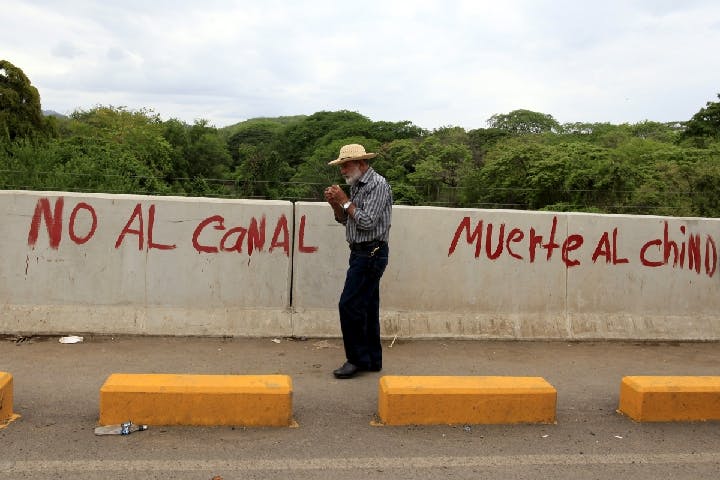A China-backed Panama Canal… in Nicaragua?
– Carlo Massimo
A former revolutionary and a Chinese billionaire have teamed up to build a second Panama Canal, this time in Nicaragua. Like the first one, it’s a colonial venture.
The plan is so ambitious it sounds literary. It could have been one of the wonders of Macondo in Gabriel García Márquez’s Hundred Years of Solitude. Or maybe like his book Big Mama’s Funeral: colossal, fantastic, and deeply troubling.
The plan is to dig a second canal through Central America, to rival Panama’s. This new canal would cut across Nicaragua from Brito to Punta Gorda, three times longer than the Panama Canal and with more space for supersized cargo ships. Construction will likely cost $50 billion. Nicaraguan President Daniel Ortega, former chief of the Sandinista guerrilla movement, inaugurated the project in December of 2014; the plan’s architect, and sponsor, is a Beijing-based businessman named Wang Jing.
According to his Forbes profile, Mr. Jing has a net worth of about $8.2 billion dollars, earned mostly in telecommunications. He seems an unlikely friend of President Ortega, who began his career with the affirmation that “our revolution is profoundly anti-imperialist, anti-Yankee and Marxist-Leninist.”
The canal has few supporters. President Ortega has proclaimed that the canal will bring much-needed revenue, raising GDP by 10 percent in a country where over 40 percent of the population lives below the poverty line But scientists around the world have released report after report condemning the canal, which threatens to devastate the Nicaraguan environment. Almost a million acres of rainforest and mangroves face destruction, including pristine UNESCO reserves. The country’s largest drinking water reservoir will be compromised, and the list of endangered animals that the canal threatens includes the jaguar, the ocelot, and the harpy eagle.
Nicaragua’s indigenous population, too, has found itself in the path of the oncoming canal, without having been consulted — or promised compensation — by either the government or Mr. Jing’s Hong Kong Nicaragua Canal Investment Development Company. And compensated or not, indigenous Nicaraguans will still have to deal with the heavy metals and other dangerous soil pollutants that the canal work will leave in its wake.
But with all eyes on the environment, few people are asking the obvious question: Ortega? With Jing?
Daniel Ortega came to power as a popular left wing firebrand, overthrowing the Somoza dictatorship and resisting the Reagan-funded Contra militias. But that was the 1970s and 80s. Since his return to office in 2006, Ortega has made a striking about-face, says former Times correspondent Stephen Kinzer. His government has notably courted Cargill, a company infamous for its environmental and human rights abuses. Under Ortega’s watch, yachts and “executive helicopters” have gotten tax exemptions; the Catholic Church in Nicaragua, once Ortega’s sworn enemy, has smiled on a new law banning all abortion.
Yesterday’s radical, today’s neoliberal: it’s an old story, and not just in Latin America. Mr. Jing’s phenomenal wealth tells a similar truth about China. The People’s Republic still hangs on to its Communist trappings, even as it colonizes Africa and Latin America for the sake of its billionaire investors. Last month the WQ reported on the ostensibly left-wing government of Ethiopia and its business deals with China. Beijing’s empire is spreading: it has now reached Latin America.
When Theodore Roosevelt began the construction of the Panama Canal in 1903, the newspapers called it “an act of sordid conquest” and a “vulgar and mercenary venture.” And of course, they were right: Roosevelt had to engineer a civil war in Colombia to acquire a friend in the Panamanian isthmus. Shortly before the intervention in Panama, Congress passed the Platt Amendment, forcing Cuba to house American troops and give the U.S. the last word in all of its decisions. This was the era of the Banana Wars, of the occupation of Mexico’s Tempico oilfields, of American troops protecting sugar companies in the Dominican Republic and fruit companies in Honduras and Nicaragua. It was the era of the Banana Massacre that appears in García Márquez’s One Hundred Years of Solitude, when the United Fruit Company had Colombian troops open fire on striking workers.
China, in cultivating its empire, has not yet resorted to the kind of violence that America came to represent in twentieth-century Latin America. Perhaps China’s status as an alternative superpower, a former developing country that has risen to might, gives it an air of legitimacy in Latin America and vast swathes of Africa.
But China is not a Third World country, whatever its history, any more than Daniel Ortega is a revolutionary. The Nicaragua Canal is neocolonialism at its most bizarre.
“The problem is that Caribbean reality resembles the wildest imagination,” said Gabriel García Márquez in 1981. Today, in 2015, Chinese bulldozers are clearing the jungle in Nicaragua. The biggest canal in the world, and the unlikeliest, is underway.
* * *
The Source: Ted Anderson, “Nicaragua’s Big Dig,” World Policy Journal 32.2 (2015): 28-38
Photo courtesy of Reuters/Oswaldo Rivas
